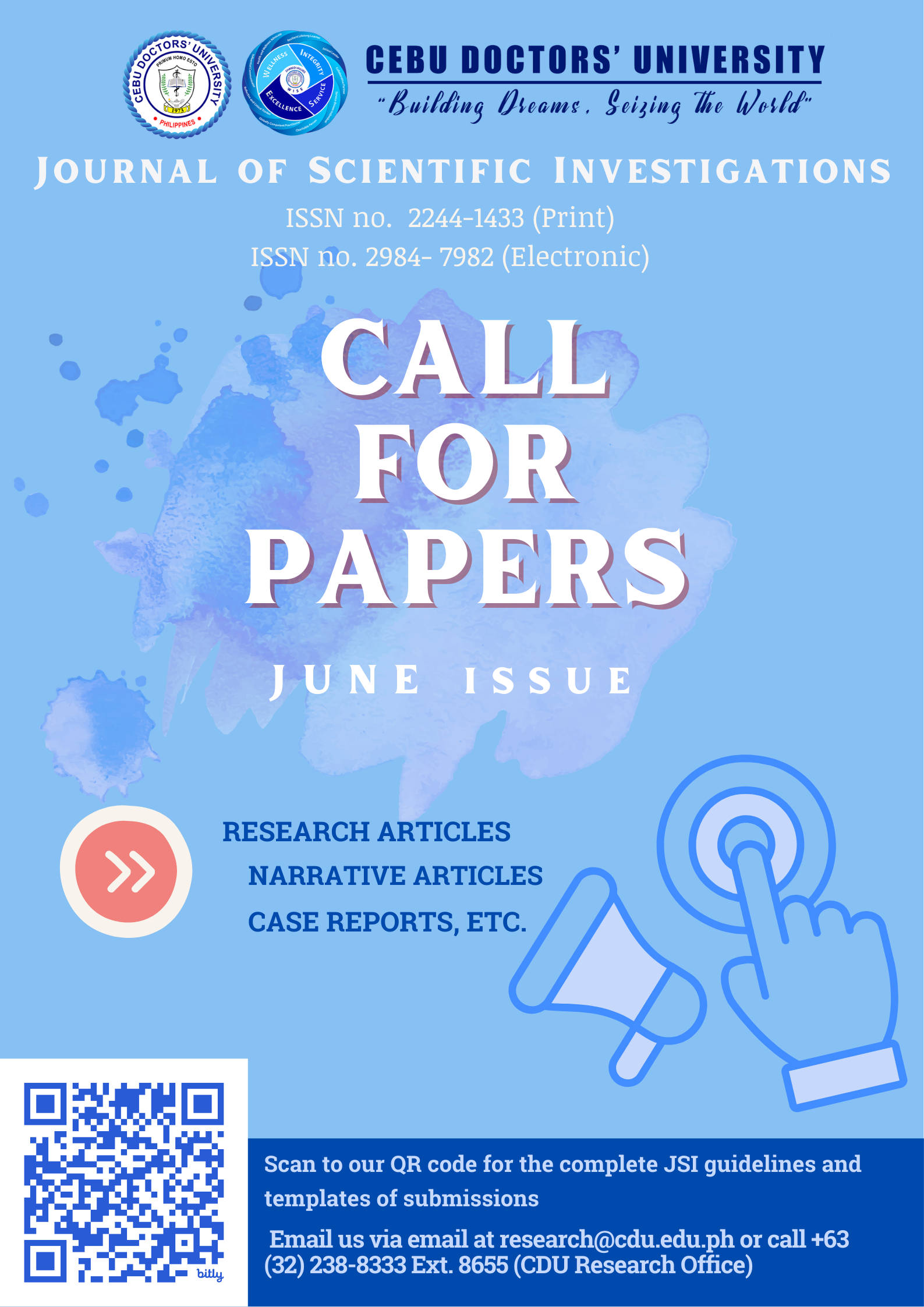Assessment of the Physical and Chemical Properties of Colocasia esculenta (Taro) Corm Gel and its Use In Ultrasound Imaging: Visibility Metric For An Alternative Sonographic Gel
Keywords:
Physical and chemical properties, taro corm, ultrasound gel, ultrasound image qualityAbstract
The high cost and unavailability of consumable supplies such as ultrasound gel affect the number and quality of ultrasound procedures in low-resource healthcare settings. This study evaluates the chemical properties of taro corm gel and its potential use as an alternative sonographic gel to produce quality ultrasound images. Spreadability, viscosity, and pH evaluation tests were done to identify the chemical properties of taro corm gel. The ultrasound images obtained from the gelatin-based ultrasound phantom were evaluated using the 10-cm Visual Analogue Scale (VAS) and a 5-point Likert scale to assess the spatial resolution and image sharpness. Seven radiology residents who were blinded to the type of gel used were asked to evaluate the 26 ultrasound images obtained using each gel type. A pilot study was undertaken to determine the interrater agreement of the researcher-made research tool for evaluating the quality of the ultrasound images. The statistical analysis of the data gathered from the tests for chemical properties and evaluation of the ultrasound image quality revealed that the taro corm gel exhibited a significantly higher spreading ability, greater alkalinity, and less viscosity than the commercial ultrasound gel (CUG). In addition, the spatial resolution and sharpness of the ultrasound images obtained from using the taro corm gel and the CUG were not significantly different, showing that the images obtained using taro corm gel were at par with the images obtained using CUG.
References
Alipio, M. M., Patrimonio, M. V. Q., Ali, A. B., Talaroc, F. R. T., Ablin, C. L. C., Naim, S. M., Borja, B. R. E. & Lantajo, G. M. A. (2020). Feasibility of extracts of common Philippine succulents as ultrasound acoustic gel alternatives. Acta Medica Philippina, 56(7), 58-63.
Alipio, M. M. (2021). Okra (Abelmoschus esculentus L. Moench) Pod gel as a low-cost alternative to commercial acoustic gel. Philippine Journal of Science, 150(2), 391-396.
Arora, G., Malik, K., & Singh, I. (2011). Formulation and evaluation of mucoadhesive matrix tablets of taro gum: Optimization using response surface methodology. Polimery w Medycynie, 41(2), 23-24.
Aziz, A., Dar, P., Hughes, F., Solorzano, C., Muller, M. M., Salmon, C., Salmon, M. & Benfield, N. (2018). Cassava flour slurry as a low‐cost alternative to commercially available gel for obstetrical ultrasound: A blinded non‐inferiority trial comparison of image quality. BJOG: An International Journal of Obstetrics & Gynaecology, 125(9), 1179-1184. https://doi.org/10.1111/1471-0528.15123
Bhargava, S.K. (2010). Principles and practice of ultrasonography (2nd ed.). Jaypee Brothers Medical Publishers. https://doi.org/10.1148/radiology.138.1.152
Bierig, S. M., & Jones, A. (2009). Accuracy and cost comparison of ultrasound versus alternative imaging modalities, including CT, Mr, pet, and angiography. Journal of Diagnostic Medical Sonography, 25(3), 138-144. https://doi.org/10.1177/8756479309336240
Binkowski, A., Riguzzi, C., Price, D., & Fahimi, J. (2014). Evaluation of a cornstarch-based ultrasound gel alternative for low-resource settings. The Journal of Emergency Medicine, 47(1), e5-e9. https://doi.org/10.1016/j.jemermed.2013.08.073
Cacciapuoti, S., Masarà, A., Fabbrocini, G., & Patruno, C. (2018). Contact urticaria to ultrasound gel: A case report. Dermatitis, 29(2), 93. https://doi.org/10.1097/DER.000000000000034
Carlton, R. & Adler, A. (2013). Principles of radiographic imaging: An art and a science (5th ed.). Cengage Learning.
Chasset, F., Soria, A., Moguelet, P., Mathian, A., Auger, Y., Francès, C., & Barete, S.(2016.. Contact dermatitis due to ultrasound gel: A case report and published work review. The Journal of Dermatology, 43(3), 318-320. https://doi.org/10.1111/1346-8138.13066
Deuschle, V. C. K. N., Deuschle, R. A. N., Bortoluzzi, M. R., & Athayde, M. L. (2015). Physical chemistry evaluation of stability, spreadability, in vitro antioxidant, and photo-protective capacities of topical formulations containing Calendula officinalis L. leaf extract. Brazilian Journal of Pharmaceutical Sciences, 51, 63-75. http://doi.org/10.1590/S1984-82502015000100007
Estanqueiro, M., Amaral, M. H., & Sousa Lobo, J. M. (2016). Comparison between sensory and instrumental characterization of topical formulations: impact of thickening agents. International Journal of Cosmetic Science, 38(4), 389-398. https://doi.org/10.1111/ics.12302
Hussey, M. (1985). Basic physics and technology of medical diagnostic ultrasound. MacMillan Publishers LTD. https://doi.org/10.1007/978-1-349-17737-0
Gawai, K. M., Mudgal, S. P., & Prajapati, J. B. (2017). Stabilizers, colorants, and exopolysaccharides in yogurt. In N. P. Shah (Ed). Yogurt in health and disease Prevention. (pp. 49-68). Academic Press. https://doi.org/10.1016/B978-0-12-805134-4.00003-1
Moreno, E., Macías, E., Dávila, I., Laffond, E., Asensio, T., Muñoz, F., & Lorente, F. (2009). Recurring eczema during pregnancy and after delivery due to sensitization caused by an ultrasound gel. Ultrasound in Obstetrics and Gynecology, 34(1), 120-121. https://doi.org/10.1002/uog.6425
Mueller, R. L., & Theoharis, E. (2013). Allergy and other risks of ultrasound gel: Recognition and alternative coupling agents. Journal for Vascular Ultrasound, 37(3), 125-132. https://doi.org/10.1177/154431671303700302
Richardson, C., Bernard, S., & Dinh, V. A. (2015). A cost‐effective, gelatin‐based phantom model for learning ultrasound‐guided fine‐needle aspiration procedures of the head and neck. Journal of Ultrasound in Medicine, 34(8), 1479-1484. https://doi.org/10.7863/ultra.34.8.1479
Riguzzi, C., Binkowski, A., Butterfield, M., Sani, F., Teismann, N., & Fahimi, J. (2017). A randomised experiment comparing low-cost ultrasound gel alternative with commercial gel. Emergency Medicine Journal, 34(4), 227-230. https://doi.org/10.1136/emermed-2016-206169
Salmon, M., Salmon, C., Bissinger, A., Muller, M.M., Gebreyesus, A. Geremew, H., Wendell, S. Azaza, A., Salumu, M., & Benfield, N. (2015). Alternative ultrasound gel for a sustainable ultrasound program: Application of human centered design. PLOS One, 10(8), e0138400 https://doi.org/10.1371/journal.pone.0134332
Simpson, C. O. (2009). Objective image quality metrics for ultrasound imaging (Master’s thesis, Norwegian University of Science and Technology). NTNU Open. https://ntnuopen.ntnu.no/ntnu-xmlui/bitstream/handle/11250/2369181/347762_FULLTEXT01.pdf?sequence=1&isAllowed=y
Stewart, K. A., Navarro, S. M., Kambala, S., Tan, G., Poondla, R., Lederman, S., Barbour, K., & Lavy, C. (2020). Trends in ultrasound use in low and middle income countries: a systematic review. International Journal of Maternal and Child Health and AIDS, 9(1), 1. https://doi.org/10.2106/ijma.294
Strauss, M. S. (1983). Anatomy and morphology of taro, Colocasia esculenta (L.) In J.K. Wang & S. Higa (Eds.), Taro: A review of Colocasia esculenta and its potentials (pp. 20-33). University of Hawaii Press.
Villanueva, M. R., & Tupas, G. L. (1982). Taro production in the Philippines–Its prospects and problems. IFS Prov. Rep, (5), 99-1.
Wang, J. K., & Higa, S. (1983). Taro, a review of Colocasia esculenta and its potentials. Honolulu: University of Hawaii Press.
Downloads
Published
How to Cite
Issue
Section
License
Copyright (c) 2022 JOURNAL OF SCIENTIFIC INVESTIGATIONS

This work is licensed under a Creative Commons Attribution-NonCommercial 4.0 International License.
Authors retain copyright and grant the journal right of first publication with the work simultaneously licensed under a Creative Commons Attribution-Non-Commercial 4.0 International License that allows others to share the work with an acknowledgment of the work's authorship and initial publication in this journal. Readers can freely access and download the PDF, but for non-commercial purposes only and should not be used for monetary purposes.




